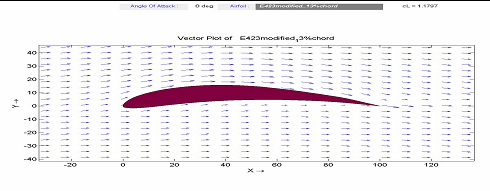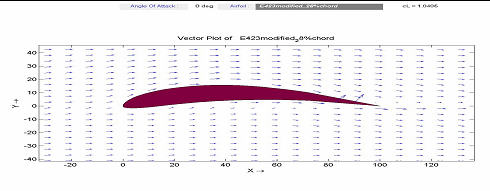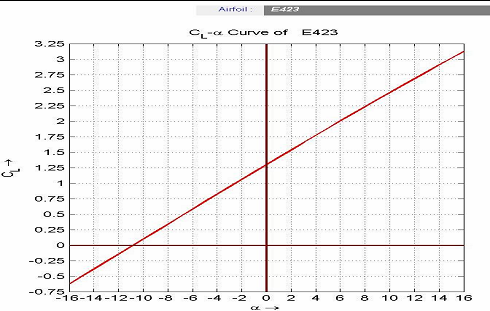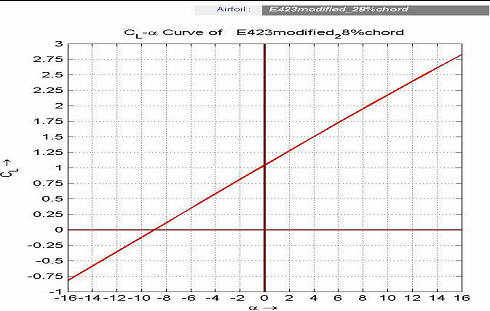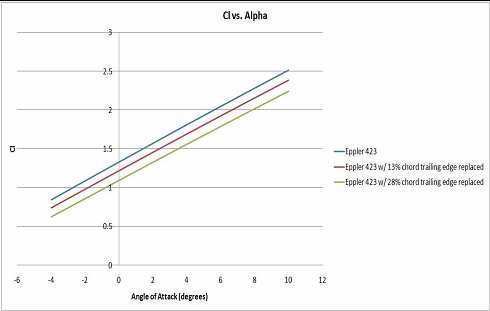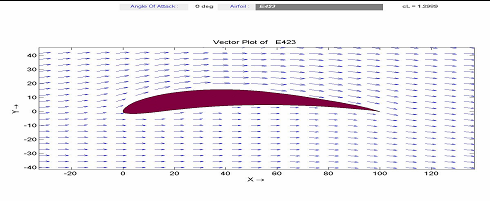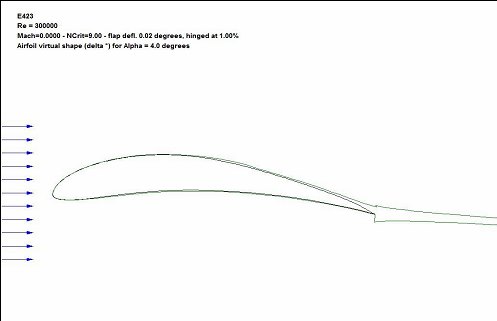Vortex Panel Method - MATLAB
The group decided on the Eppler 423 high lift airfoil because of the high lift capacities and ease of construction. Another option was the Selig 1223 high lift airfoil. The Selig 1223 airfoil has a higher lift coefficient. However, the trailing edge on the Eppler 423 was thicker and appeared easier to construct. To combat the loss of initial lift on the Eppler 423 airfoil, a gurney flap of 2-3% chord thickness will be placed near the end of the trailing edge.
However, the group noticed later on that the ability to make a concave surface at the trailing edge may become difficult during construction. The group also became aware that there may be the ability to build the trailing edge out of triangular stock balsa wood. This would be difficult to sand and form to the exact contour of the original airfoil. Because of this, the group ran simlulations on airfoils where the trailing edge started at 13% and 28% chord length. The trailing edge of the airfoil can be seen changed below in the profile flow view below. The effects of these changes in the airfoil are seen below in the revised graphs.
Above is the profile shape where the trailing edge is replaced at 13% chord length with a triangular balsa block that runs tangent with the concavity and makes a point at the very end. The coefficient of lift has been lowered due to this change.
Above is the profile shape where the trailing edge is replaced at 28% chord length with a triangular balsa block that runs tangent with the concavity and makes a point at the very end. The coefficient of lift has been lowered due to this change.
Above is the difference that the change in the trailing edge has on the coefficient of lift. The further up the airfoil that the trailing edge is repalced with triangular balsa stock, the lower the overall coefficient of lift.
Team Ninja Turtles used a variety of software and hardware for the construction of Splinter. Among these, the most important to the team were the following:
MATLAB
SolidWorks
Cosmoworks
Profili 2.21
NAU Student Machine Shop
Team Ninja Turtles would like to thank NAU and all of their affiliates for the use of their facilities during this project. The team would also like to especially thank the NAU machine shop for putting up with all of the saw dust created during the construction process.
What follows below is some of the analysis that was performed during the design and construction of Splinter.
SolidWorks
For a viewing of the work done in SolidWorks for this project, please consult the CAD Drawings page.
Cosmoworks
For a viewing of the work done in Cosmoworks for this project, please consult the CAD Drawings page.
Profili 2.21
Team Ninja Turtles would like to thank Duranti Stefano from Italy for supplying us with this program. ALthough the team had to purchase the product, it was extremely valuable to the project. Profili 2.21 allowed the team to get accurate airfoil plots and print them out to aid in the construction of the wing. Profili 2.21 also allowed the team to do analysis on the different airfoils available for selectiong during wing design. This type of analysis included the following:
Lift Coefficients
Drag Coefficients
Gurney Flap Analysis
Pressure Distribution
The generated graphs and descriptions of the lift vs drag analysis and the gurney flap visualization are provided below.
The objective of designing our wing was to get the maximum lift to drag ratio. By comparing these values versus a wide range of angle of attacks, Team Ninja Turtles was able to decide upon an angle of attack that would generate the highest ratio of lift versus drag.
As gurney flaps are relatively new in the field of aerodynamics, we were fortunate to be able to find an easy to use program that would give a visualitation of what was happening in the flow of the airfoil.



